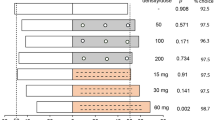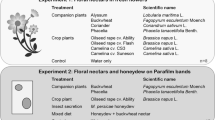Abstract
Three field experiments were conducted to determine the attractiveness of artificial honeydews and aphid juice to insects. Honeydew mixtures were composed of molasses, honey and tryptophane alone or combined with Feed-Wheast®, (produced by culturing the yeastKluyveromyces fragilis Jorgensen on cottage cheese whey). Potato plants,Solanum tuberosum L., treated with sprays of these mixtures attracted the following predatory insects: green lacewings,Chrysopa carnea Stephens; ladybird beetlesHippodamia spp.,Coccinella transversoguttata Brown,Scymnus postpinctus Casey; andGeocoris pallens Stal.Lygus hesperus Knight, a phytophagous species was also attracted. Honey and tryptophane were the most attractive to all species. Aphid juice was attractive to several predators but not to lygus bugs. Orientation through olfactory response was indicated for ladybird beetles and lygus bugs. The predatory species attracted are important in the natural control of potato insects. The attraction ofL. hesperus to artificial honeydews may be useful in the control of this pest.
Résumé
Trois essais ont été réalisés pour déterminer la capacité d'attraction de mélanges de «miellats’ artificiels et d'un extrait de pucerons sur les insectes. Ces mélanges de «miellat» consistaient en mélasses, miel et tryptophane seul ou combiné avec du Feed-Wheast® produit à l'aide de levain deKlyuveromyces fragilis Jorgensen sur un substrat de petit-lait de sérac. Les plantes de pomme de terreSo lanum tuberosum L. pulvérisées avec ces mélanges ont attiré les insectes prédateurs suivants: hémérobes,Crysopa carnea Stephens, coccinellesHippodamia spp.,Coccinella transversoguttata Brown,Scymnus postpinctus Casey; etGeocoris pallens Stal.,Lygus hesperus Knight; une espéce phytophage fut aussi attirée. Le miel et le tryptophane se sont révélés les plus attractifs pour toutes les espèces. L'»extrait de pucerons» a attiré beaucoup de prédateurs, excepté le lygus. Une réponse olfactive suivant l'orientation a été constatée pour les coccinelles et les lygus. Les espèces prédatrices ainsi attirées sont importantes pour le contrôle naturel des ravageurs des pommes de terre. L'attraction desL. hesperus pour les mélanges de «miellat» artificiel pourrait être utilisée pour lutter contre ce ravageur.
Similar content being viewed by others
References
Ben Saad, A.A., Bishop, G.W. — 1972. The use of food sprays to augment the natural enemies of potato insects. —Abstract 14th Int. Congr. Entomol., 214.
Ben Saad, A.A., Bishop, G.W. — 1974. Effect of artificial honeydews on numbers of insects in potato fields. — (in press: to be published in University of Idaho, Dept. Entomol. Golden Jubilee Volume.)
Colburn, R. &Asquith, D. — 1970. A cage used to study the finding of a host by the ladybird beetle,Stethorus punctum. —J. Econ. Entomol., 63, 1376–7.
Davidson, W.M. — 1923. Biology ofScymnus nubes Casey [Coleoptera: Coccinellidae]. —Trans. In. Entomol. Soc., 49, 155–63.
Ewart, W.H. &Metcalf, R.L. — 1956. Preliminary studies of sugar and amino acids in the honeydews of five species of coccids feeding on citrus in California. —Ann. Entomol. Soc. Am., 49, 441–7.
Fleschner, C.A. — 1950. Studies on searching capacity of the larvae of three predators of the citrus red mite. —Hilgardia, 20, 233–65.
Gray, R.A. — 1952. Composition of honeydew excreted by pineapple mealybugs. —Science, 115, 129–33.
Hagen, K.S. — 1958. Honeydew as an adult fruit-fly diet affecting reproduction. —Proc. 10th Int. Congr. Entomol., Montreal, 3, 25–30.
Hagen, K.S. — 1962. Biology and ecology of predaceousCoccinellidae. —Annu. Rev. Entomol., 7, 289–326.
Hagen, K.S., Sawall, E.F. Jr. &Tesssan, R.L. — 1970. The use of food sprays to increase effectiveness to entomophagous insects. —Proc. Tall Timbers Conf. Ecol. Anim. Contr. by Habitat Management, 1, 59–81.
Hagen, K.S., Greany, P. & Sawall, E.F. Jr. — 1975. Isolation of tryptophane from artificial honeydew as an attractant for adultChrysopa carnea. —Entomol. Exp. Appl., 18.
Hagen, K.S. &Tassan, R.L. — 1966. The influence of protein hydrolysate of yeasts and chemically defined diets upon fecundity ofChrysopa carnea Stephens. —Vestnik Cs. Spol. Zool. 30, 219–27.
Knowlton, G.F. — 1936. The insect fauna of Utah (from the standpoint of an economic entomologist). —Utah Acad. Sci., 13, 249–62.
Knowlton, G.F. — 1943.Nabis alternatus feeding observations. —Brooklyn Entomol. Soc. Bull., 38, 122.
Maltaise, J.B. &Auclair, J.L. — 1952. Occurrence of amino acids in honeydew of the crescentmarked lily aphidMyzus circumflexus (Buck.). —Can. J. Zool., 30, 191–3.
Mittler, T.E. — 1958. Studies on feeding and nutrition ofTuberolachnus salignus (Gmelin) [Homoptera, Aphididae]. II. The nitrogen and sugar composition of ingested phloem sap and excreted honeydew. —J. Exp. Biol., 35, 74–84.
Putman, W.L. — 1955. Bionomics ofStethorus punctillum Weise [Coleoptera: Coccinellidae] in Ontario. —Can. Entomol., 87, 9–33.
Shands, W. A., Holmer, R. L. &Simpson, G. W. — 1970. Improved laboratory production of eggs ofCoccinella septempunctata. —J. Econ. Entomol., 63, 315–7
Smith, B.C. — 1965. Growth and development of coccinellid larvae on dry foods [Coleoptera: Coccinellidae]. —Can. Entomol., 97, 760–8.
Szumkowski, W. — 1961. Dietas sin insectos vivos para cria deColeomegilla maculata Deg. [Coccinellidae, Coleoptera]. —Agron. Trop. (Venezuela), 10, 149–54.
Tamaki, G. — 1972. Biology and ecology of two predators,Geocoris pallens Stal andG. bullatus (Say) —U.S.D.A. Tech. Bull., 1446, 46 p.
Thompson, W.L. — 1928. The seasonal and ecological distribution of the common aphid predators of central Florida. —Fla Entomol., 11, 49–52.
Thompson, W.L. — 1951. The specificity of host relations in predaceous insects. —Can. Entomol., 83, 262–9.
Zaugg, J.L. &Nelson, M.W. — 1974.Lygus hesperus: comparison of olfactory response between laboratory-reared and field-collected adults. —J. Econ. Entomol., 67, 133–4.
Zoebelein, G. — 1956. Der Honigtau als Nahrung der Insekten. Teil I. —Z. Angew. Entomol., 38, 369–416.
Author information
Authors and Affiliations
Additional information
This study is a part of a Ph. D. dissertation submitted to the University of Idaho.
Published with the approval of the Director, Idaho Agricultural Experiment Station as Research Paper no. 1463.
Rights and permissions
About this article
Cite this article
Ben Saad, A.A., Bishop, G.W. Attraction of insects to potato plants through use of artificial honeydews and aphid juice. Entomophaga 21, 49–57 (1976). https://doi.org/10.1007/BF02372015
Issue Date:
DOI: https://doi.org/10.1007/BF02372015




